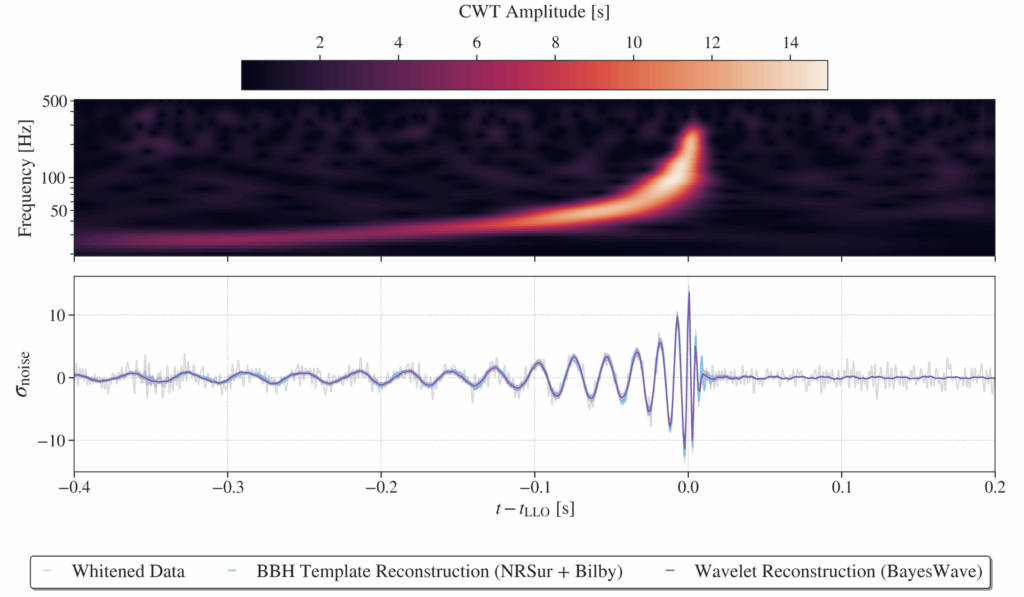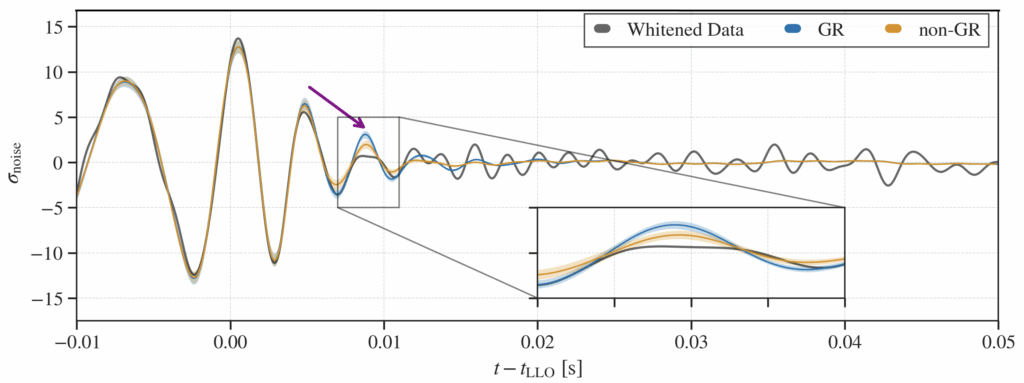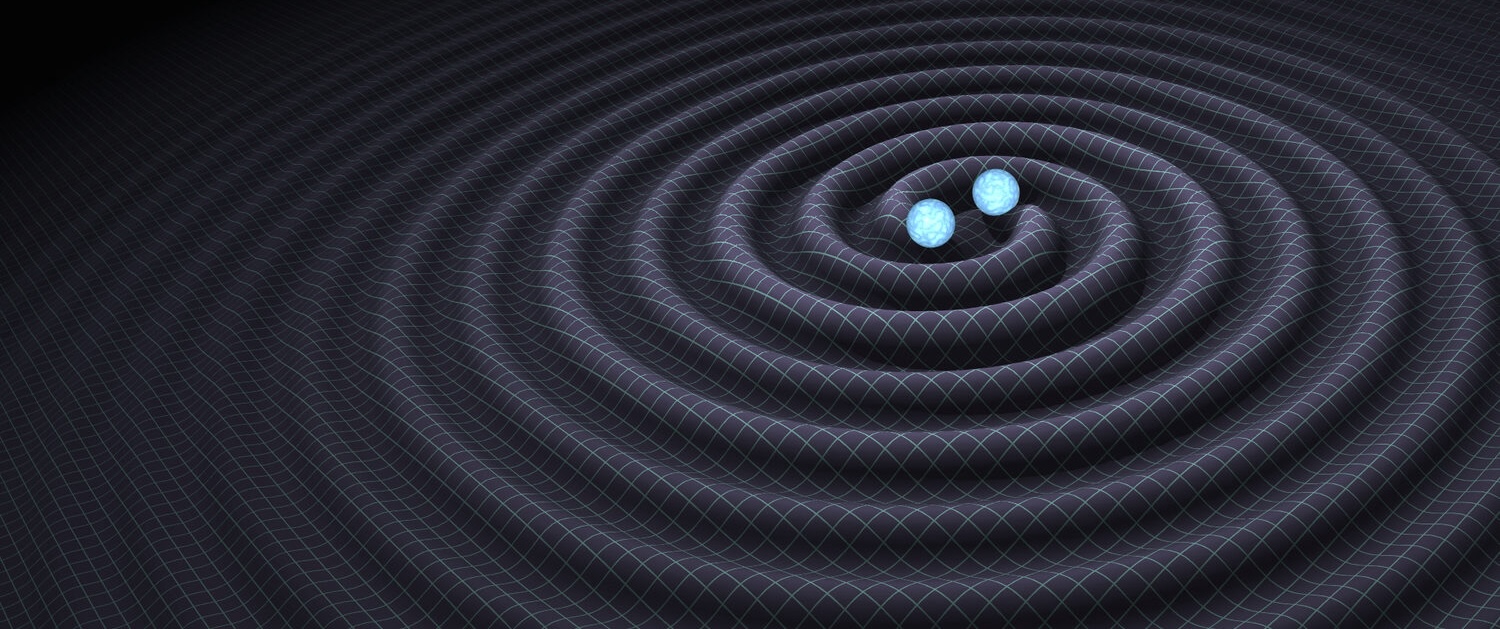The LIGO-Virgo-KAGRA collaborations have observed a particularly loud gravitational-wave signal with the LIGO Livingston detector. GW230814 was detected on August 14th, 2023, at 23:09:01 UTC. The gravitational wave signal is likely to have originated from the merger of two black holes.
Detecting the signal
GW230814 was observed during the first part of the fourth observing run (O4a). At the time of the observations, only the Advanced LIGO Livingston detector was taking data. Despite being observed by only one detector, the signal is particularly loud. Figure 1 shows different representations of the GW230814 signal.

Figure 1: The gravitational-wave signal GW230814. The top panel shows the time-frequency representation of the signal where brighter regions indicate larger amplitude. The CWT acronym points to the method used to construct this time-frequency representation, based on the Continuous Wavelet Transform. The bottom panel shows the signal represented as a time series. The blue and purple lines show two different methods of reconstruction for the signal waveform. It is clear that the signal is a compact binary coalescence and the data are in good agreement with the reconstructions until the ringdown part (as discussed in the main text).
What does loud mean?
Any gravitational-wave observation data contains a mix of signal (coming from the cosmos) and noise (from the detector and its environment). We measure the loudness of a gravitational-wave signal using the signal-to-noise ratio (SNR) figure of merit. This number describes how loud a signal is in comparison to the noise in the data. The single detector SNR for GW230814 is about 42. For comparison, the first gravitational-wave observation, GW150914, was also loud with an SNR of 24.
The binary black hole merger that made GW230814
GW230814 is consistent with a signal coming from the merger of a binary black hole system. To learn more about the properties of the binary that produced the signal—such as the masses and spins of the black holes—we compared the data to simulated signals based on Einstein’s theory of General Relativity (GR). From this, we found that GW230814 likely came from the merger of two black holes with masses 34 and 28 times the mass of the sun—strikingly similar to the very first detection, GW150914.
This cosmic event happened about 300 megaparsecs from Earth – that’s about a billion light years away. However, with a single detector, it is not possible to determine the direction in the sky of a given signal, unless the signal is very long. Normally, the joint observation of the same signal by at least three detectors is necessary (though not always sufficient) to precisely locate in the sky a short-duration gravitational wave source like GW230814, as was the case with GW170817 about 8 years ago.
A puzzling signal: putting general relativity to the test
Gravitational-wave signals can be used to test Einstein’s theory of GR. The LIGO-Virgo-KAGRA collaborations run a suite of different tests to check whether or not a particular gravitational-wave signal is consistent with what you would expect from GR. You might be wondering why we still test GR when it has been tried and tested many times over the last century. Just like any other physical theory, GR may be an approximation to a more complete theory that remains to be discovered. That is just what happened a century ago when Einstein’s theory of GR extended the Newtonian theory of gravitation by explaining phenomena that Newton’s laws could not.
When testing GR using gravitational waves, we typically only use loud signals observed by two or more detectors. However, being particularly loud makes GW230814 quite an interesting case. To understand why it is interesting, we first need to think about the different stages of a gravitational-wave signal from merging black holes.
Compact binary merger gravitational-wave signals are comprised of three stages, as illustrated in Figure 2:
- The inspiral is when the two black holes are spiraling together, slowly coming closer to one another. At this stage, the gravitational-wave signal is increasing in frequency and amplitude.
- The plunge-merger is when the two black holes are in the process of merging, and the gravitational wave amplitude is highest.
- The ringdown is after the plunge-merger, when the newborn black hole settles down by emitting gravitational waves with ever-decreasing amplitude. If you imagine hitting a bell (which would correspond to the plunge-merger), then after it is struck the bell continues to make a sound which fades away to silence – this is the ringdown.

Figure 2: The typical evolution of a gravitational-wave signal from a merging binary system. This illustrative plot shows the signal amplitude (vertical axis) against time (horizontal axis). The different phases of the signal are the inspiral (orange), the plunge-merger (light-green) and the ringdown (yellow). Also shown are the technical names of different tests of general relativity performed, and the parts of the signal they consider – see the scientific article for more details.
The tests of GR used by the LIGO-Virgo-KAGRA collaborations study different parts of the signal. Tests focusing on the inspiral part of GW230814 show that the signal is consistent with GR. However, the tests that focus on the plunge-merger-ringdown part of the signal paint a more puzzling picture. The ringdown of GW230814 fades away more quickly than would be expected by GR. This is shown in Figure 3, where the peak immediately after the merger is smaller than the GR prediction.
What causes this difference between the data and the GR prediction? Several avenues of investigation have been explored. One line of investigation looked at whether subdominant ringdown modes could be the cause. Subdominant ringdown modes in a gravitational-wave signal are similar to higher harmonics in audio waves. Another investigation looked at whether the gravitational-wave signal could have been affected by gravitational lensing. However, the evidence is not convincing for either of these explanations.

Figure 3: Comparing the GW230814 data (shown in grey) to reconstructed waveforms corresponding to a GR model (blue) and non-GR model (orange). The purple arrow highlights the part of the signal (shown enlarged in the inset box) where the observed amplitude of the data is lower than expected from GR. One can note that the horizontal axis covers only six hundredths of a second (with time=0 corresponding to the plunge-merge phase): gravitational-wave studies have truly entered the precision era! Image credit: Rossella Gamba/Koustav Chandra/LIGO-Virgo-KAGRA.
A third possibility is that the apparent inconsistency could be due to limitations in the accuracy of our GR gravitational waveform models, rather than an actual deviation from GR. A loud signal like GW230814 is more likely to reveal such inaccuracies as more details of the gravitational wave become visible. Our tests indicate that waveform accuracy limitations could indeed be a credible explanation for the apparent inconsistency.
Another possible explanation is that the inconsistency is due to random noise fluctuations in the data. A random noise fluctuation at the same time as the ringdown part of the gravitational wave could mean that the signal only appears to be inconsistent with GR. To test this hypothesis, we did trials—just like how we can test whether dice are loaded by rolling them many times. Here we cannot merge black holes on demand and so computers simulate those mergers for us, relying on GR to generate the gravitational waves. Thus, we can create many fakesimulated gravitational-wave signals like GW230814 and add realistic (but randomly fluctuating) noise to them. Then, we redo our tests of GR with each simulated signal. The results indicate that it is also possible that a random noise fluctuation could be the cause of the apparent inconsistency with GR.
The importance of a detector network
Gravitational-wave observatories work best as a detector network. A gravitational-wave signal detected across multiple independent detectors enables signal verification, better estimation of the source properties, and localization of the origin of the signal on the sky.
The case of GW230814 highlights the importance of a detector network (just as was the case with another binary black hole merger, GW170814, that was detected exactly six years earlier and was the first signal observed by three interferometers). Having data from only one detector restricts the set of possible measurements that can be made and strongly limits their accuracy. While scientists are working very hard to achieve the goal of a global detector network, we cannot expect all parts of it to be up and running 24/7. Therefore, the larger the network, the better! Currently (2025), the LIGO-Virgo-KAGRA network includes four detectors: two from LIGO located in the USA, the European Virgo instrument in Italy, and KAGRA in Japan. The three Collaborations operate the network globally to maximize the scientific outcomes from the search for gravitational waves.
A bright (and loud) future
As the LIGO-Virgo-KAGRA Collaborations mark 10 years since the first direct detection of gravitational waves, we can anticipate many more loud signals to come as the sensitivity of our detector network continues to improve. Such events will provide further opportunities to explore the properties of black holes, as well as continuing to put Einstein’s General Relativity to the test.
Find out more:
- Visit our websites:
- Read a free preprint of the full scientific article here or on arXiv here.
- Gravitational-Wave Open Science Centre (GWOSC) data release for GW230814 available here.
- GWOSC data release for GWTC-4.0 available here.
Back to the overview of science summaries.

